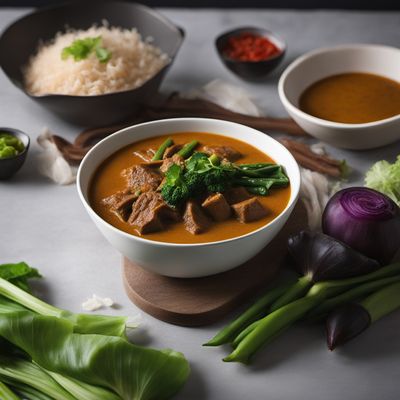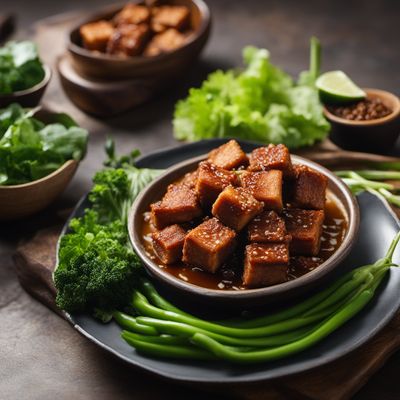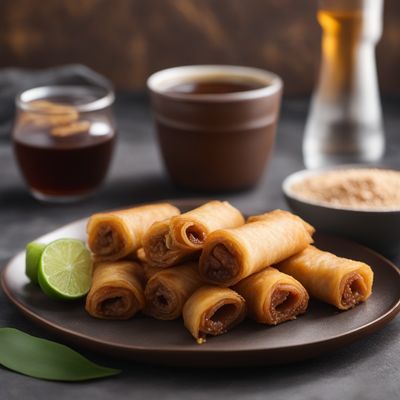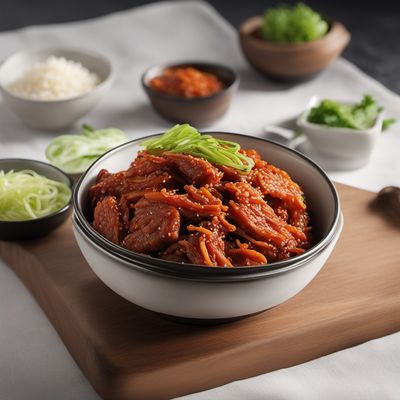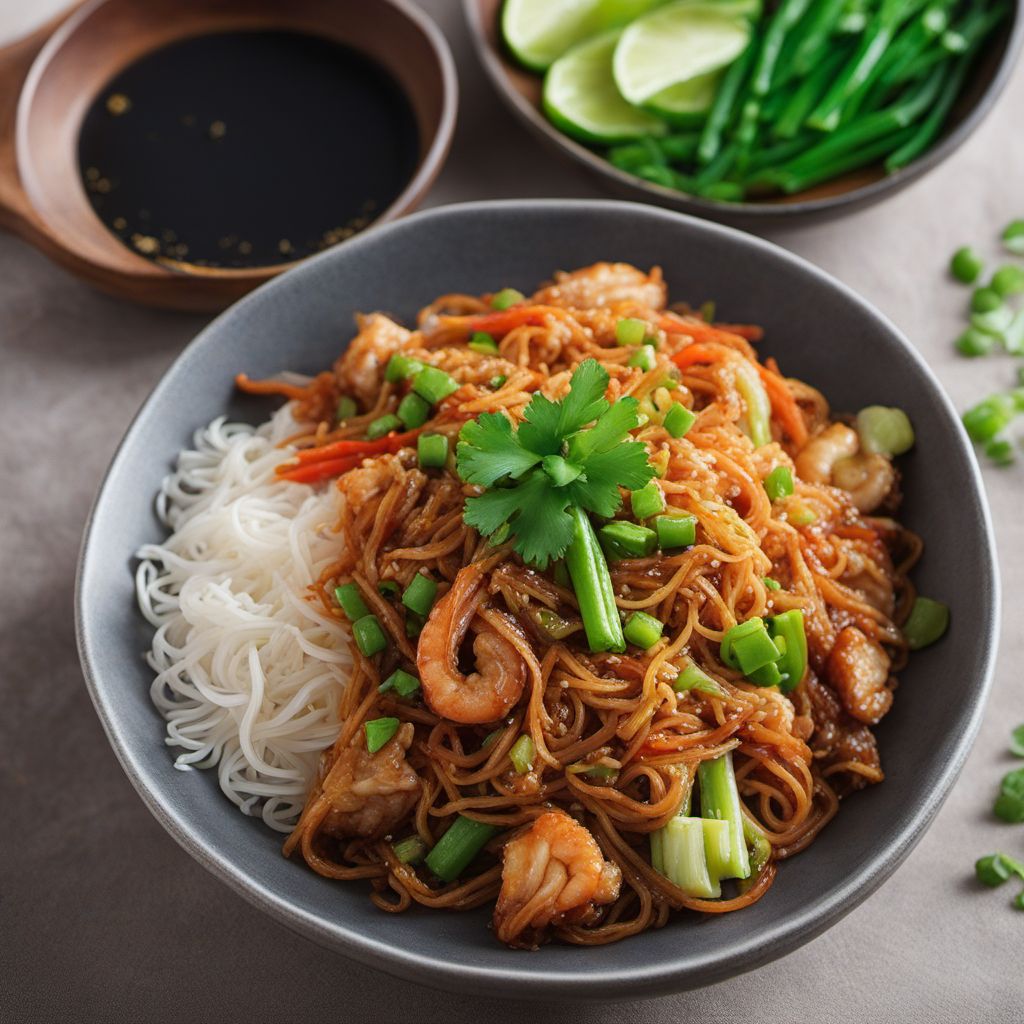
Recipe
Korean Chinese Pancit Malabon
Savory Fusion: Korean Chinese Pancit Malabon
4.7 out of 5
Indulge in the delightful fusion of Korean and Chinese flavors with this Korean Chinese Pancit Malabon recipe. This dish combines the traditional Filipino pancit with the bold and vibrant taste of Korean Chinese cuisine.
Metadata
Preparation time
30 minutes
Cooking time
20 minutes
Total time
50 minutes
Yields
4 servings
Preparation difficulty
Medium
Suitable for
Pescatarian, Dairy-free, Nut-free, Shellfish-free, Egg-free
Allergens
Shellfish (shrimp, squid)
Not suitable for
Vegetarian, Vegan, Gluten-free, Soy-free, Paleo
Ingredients
In this Korean Chinese adaptation of Pancit Malabon, we incorporate Korean Chinese flavors and ingredients to give the dish a unique twist. The traditional Filipino pancit is transformed by using Korean spices and sauces, such as gochujang and soy sauce, to infuse the dish with a distinct Korean Chinese taste. The addition of Korean vegetables like napa cabbage and Korean chili peppers adds an extra layer of flavor and heat. This fusion recipe combines the best of both worlds, creating a delightful blend of Filipino, Korean, and Chinese culinary traditions. We alse have the original recipe for Pancit malabon, so you can check it out.
-
500g (1.1 lb) thick rice noodles 500g (1.1 lb) thick rice noodles
-
250g (8.8 oz) shrimp, peeled and deveined 250g (8.8 oz) shrimp, peeled and deveined
-
250g (8.8 oz) squid, cleaned and sliced into rings 250g (8.8 oz) squid, cleaned and sliced into rings
-
200g (7 oz) pork belly, thinly sliced 200g (7 oz) pork belly, thinly sliced
-
1 cup napa cabbage, shredded 1 cup napa cabbage, shredded
-
1 cup carrots, julienned 1 cup carrots, julienned
-
1 cup green beans, sliced 1 cup green beans, sliced
-
1 cup bean sprouts 1 cup bean sprouts
-
4 cloves garlic, minced 4 cloves garlic, minced
-
1 onion, chopped 1 onion, chopped
-
2 tablespoons vegetable oil 2 tablespoons vegetable oil
-
2 tablespoons gochujang (Korean chili paste) 2 tablespoons gochujang (Korean chili paste)
-
2 tablespoons soy sauce 2 tablespoons soy sauce
-
1 tablespoon oyster sauce 1 tablespoon oyster sauce
-
1 tablespoon sesame oil 1 tablespoon sesame oil
-
1 teaspoon sugar 1 teaspoon sugar
-
Salt and pepper to taste Salt and pepper to taste
-
Korean chili peppers, sliced (optional, for garnish) Korean chili peppers, sliced (optional, for garnish)
-
Spring onions, chopped (for garnish) Spring onions, chopped (for garnish)
Nutrition
- Calories (kcal / KJ): 450 kcal / 1884 KJ
- Fat (total, saturated): 15g, 4g
- Carbohydrates (total, sugars): 60g, 5g
- Protein: 20g
- Fiber: 5g
- Salt: 2g
Preparation
-
1.Cook the thick rice noodles according to package instructions. Drain and set aside.
-
2.In a large wok or pan, heat the vegetable oil over medium heat. Add the minced garlic and chopped onion, and sauté until fragrant.
-
3.Add the pork belly slices and cook until browned and crispy. Remove from the pan and set aside.
-
4.In the same pan, add the shrimp and squid. Cook until they turn pink and opaque. Remove from the pan and set aside.
-
5.Add the shredded napa cabbage, julienned carrots, sliced green beans, and bean sprouts to the pan. Stir-fry for a few minutes until the vegetables are slightly tender.
-
6.In a small bowl, mix together the gochujang, soy sauce, oyster sauce, sesame oil, sugar, salt, and pepper. Pour the sauce over the vegetables in the pan and stir to coat evenly.
-
7.Add the cooked noodles to the pan and toss gently to combine with the sauce and vegetables. Cook for a few more minutes until everything is heated through.
-
8.Return the cooked pork belly, shrimp, and squid to the pan. Stir-fry for another minute to incorporate all the flavors.
-
9.Remove from heat and garnish with sliced Korean chili peppers (if desired) and chopped spring onions.
-
10.Serve hot and enjoy the delicious fusion of Korean Chinese Pancit Malabon!
Treat your ingredients with care...
- Shrimp — Make sure to devein and peel the shrimp before cooking to remove any grit or impurities.
- Squid — Clean the squid thoroughly by removing the innards and transparent cartilage. Slice it into rings for even cooking.
- Gochujang — Adjust the amount of gochujang according to your spice preference. Add more for a spicier dish or reduce it for a milder flavor.
- Napa cabbage — Shred the napa cabbage finely to ensure it cooks quickly and evenly.
Tips & Tricks
- If you prefer a vegetarian version, you can omit the meat and seafood and add more vegetables like mushrooms and bell peppers.
- For a spicier kick, add sliced Korean chili peppers to the dish or serve them as a garnish.
- Feel free to customize the vegetables according to your preference or what's in season.
- If you can't find thick rice noodles, you can substitute with udon noodles or any other thick Asian noodles.
- Leftovers can be stored in an airtight container in the refrigerator for up to 3 days.
Serving advice
Serve Korean Chinese Pancit Malabon hot as a main course. Garnish with sliced Korean chili peppers and chopped spring onions for added flavor and visual appeal. Pair it with a side of kimchi or pickled vegetables to complement the fusion flavors.
Presentation advice
Present the Korean Chinese Pancit Malabon in a large serving dish, showcasing the vibrant colors of the noodles, vegetables, and seafood. Sprinkle some chopped spring onions and sliced Korean chili peppers on top for an attractive garnish. Serve with chopsticks and a side of kimchi for an authentic Korean Chinese dining experience.
More recipes...
More Filipino cuisine dishes » Browse all
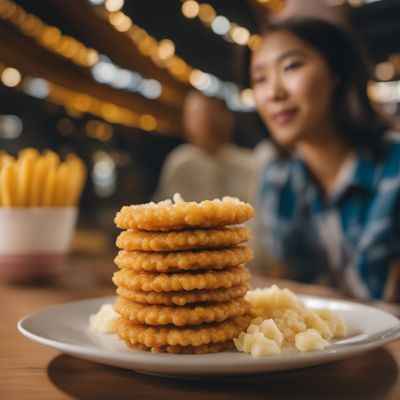
Maruya
Maruya is a popular Filipino snack made of mashed bananas coated in batter and deep-fried. It is a sweet and crunchy snack that is perfect for any...

Buñelos uhang
Shrimp Fritters
Buñelos uhang is a popular Filipino dish that is known for its unique combination of sweet and savory flavors. It is a perfect dish for a special...

Lauya
Pork and vegetable soup
Lauya is a traditional Filipino soup that is typically made with pork and vegetables. It is a hearty and flavorful dish that is popular throughout...


